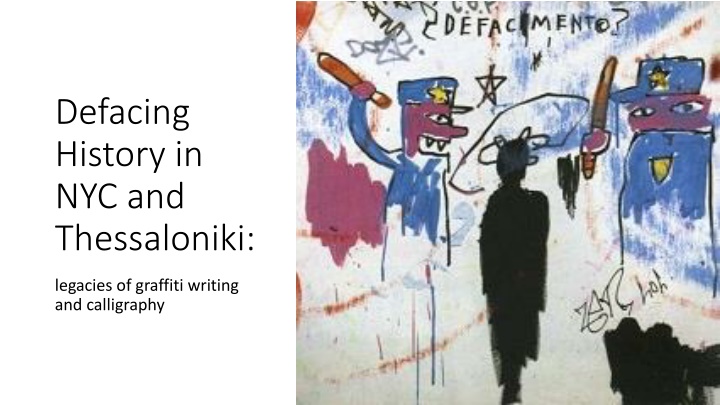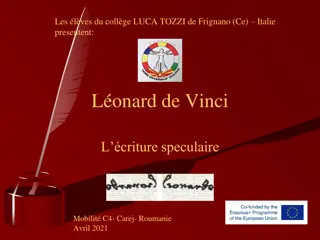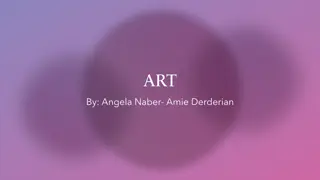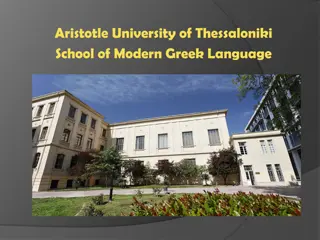Legacy of Graffiti Writing and Calligraphy in NYC and Thessaloniki
Delve into the impact of urban renewal on historical graveyards in NYC and Thessaloniki, examining conflicts between multicultural theory and practice. Explore the transformation of sacred spaces into modern landscapes, reflecting on the cultural significance of burial rituals and the preservation of memory amidst changing societal norms.
Download Presentation

Please find below an Image/Link to download the presentation.
The content on the website is provided AS IS for your information and personal use only. It may not be sold, licensed, or shared on other websites without obtaining consent from the author.If you encounter any issues during the download, it is possible that the publisher has removed the file from their server.
You are allowed to download the files provided on this website for personal or commercial use, subject to the condition that they are used lawfully. All files are the property of their respective owners.
The content on the website is provided AS IS for your information and personal use only. It may not be sold, licensed, or shared on other websites without obtaining consent from the author.
E N D
Presentation Transcript
Defacing History in NYC and Thessaloniki: legacies of graffiti writing and calligraphy
Broken tombstones with a Star of David mark the spot where Aristotle University now stands, a study in urban renewal, recently treated in a play about Robert Moses (starring Ralph Fiennes). At what price do we modernize. In Greek literature, burial rights are the sign of a civilization. Achilles desecration of Hector s body closes The Iliad. Are heroes the only figures worthy of burial in the Garden of Heroes (Missolonghi). Universities teach multiculturalism but the very site of Aristotle University, a former graveyard, indicates that practice conflicts with theory.
For the Jews of Salonica, the graveyard was a place of remembrance. Famous rabbis were buried there, and relatives would come to commune with their dead ancestors. Now students walk on the bones of the dead.
Here we see A funeral Carriage in the early 1900s, on the way to the Jewish graveyard. The image carries something of Emily Dickinson s Because I Could Not Stop for Death ; her notion of stopping for death, contains within its poetic language, a plea for pausing and patient remembrance. It is a warning for urban renewal, highways, impatient purveyors of progress, ethnic cleansing, and Greek nationalism
The strange clothing of the Sephardic Jews, their head-wraps and Turkish fez, show that Thessaloniki was a multi-cultural city which the Ottoman empire allowed to exist in its multicultural state, far more than the Greek Hellenists who excluded Jew from the category of Greek (see Katherine Fleming s Greece: A Jewish History.
The Greek crisis, austerity, was created in part because the Germans did not pay war reparations to the countries they destroyed, though the Marshall Plan quickly built German industry as a bulwark against Soviet expansion. The suggestion that some cultures are inferior to others, marked by wardrobe styles (leather vs. fabric) is well limned by Susan Sontag s Fascinating Fascism. Perhaps the most dangerous aspect of World War II ideologies was the obliteration of local languages (Ukrainian, Polish) in favor of Russian and German. Today, monolingualism takes the form of English only movements. Graveyards, like languages (Yiddish), mark the site of cultural memory. Only in 2014 was a plaque put up to honor the Jewish dead, whose tombstones and graves became swimming pools. Though we feel we are over the holocaust, murals honoring it are quickly defaced by the Golden Dawn.
Here is a holocaust mural that was defaced in 2019 in Thessaloniki; as with Defacement by Basquiat, graffiti plays a role in challenging suppressed histories; there is a reason why it took until 2014 for a plaque to appear honoring the Jewish graveyard that lies beneath Aristotle university and the area north of the Arch of Galerius
A Himmler looking figure watches as a boy plays, starkly depicting the imaginative poverty of fascism
The dignity and education of Sephardic Jews living in Thessaloniki is not often remembered in Holocaust videos or World War II histories that gloss over their special story . Their cultural memory can only be captured by these haunting photographs.
What makes fascism fascinating, as Susan Sontag explained, is the attempt to divorce fascism from Hitlers ideology, as in the renewed appreciation of Leni Riefenstahl as film-maker. In this photograph, we see Jewish residents of Thessaloniki exercising in heat in the public square.
Swimming pools with the tombstones of Jewish rabbis in Panorama
Lewis Mumford, 1938, on urban renewal Those who work within the metropolitan myth, treating its cancerous tumors as normal manifestations of growth, will continue to apply poultices, salves, advertising incantations, public relations magic, and quack mechanical remedies until the patient dies before their own failing eyes. No small part of the urban reform and correction that has gone on these last hundred years, and not least this last generation slum demolition, model housing, civic architectural embellishment, suburban extension, urban renewal has only continued in superficially new forms the same purposeless concentration and organic de-building that prompted the remedy (560).
References Fleming, Katherine E. (2008) Greece: A Jewish History. Princeton : Princeton U P. Papadopoulos, Alex G. And Triantafyllos G. Petridis. Hellenic Statecraft and the Geopolitics of Difference. London: Routledge.























